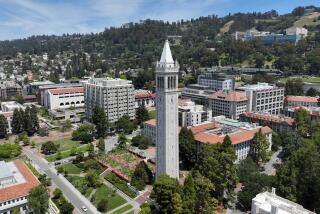Fewer County Graduates Go to State Colleges : Education: Only 13.9% entered CSU or UC after leaving high school in 1989. The average in California was 18.7%.
- Share via
Ventura County’s high school graduates are less likely to enroll in California’s four-year public colleges and universities than their counterparts across the state, records show.
The same records indicate that the county’s high school graduates enroll in two-year state colleges in slightly above-average numbers. But in overall public postsecondary enrollment, Ventura County lags behind the state at large.
“You shouldn’t be having those kinds of trends,” said Bruce Hamlett, director of legislative affairs for the California Postsecondary Education Commission, which compiles the college enrollment figures annually.
The commission’s figures do not include private universities and out-of-state campuses, which attract many top students. But the numbers are the best available measure of college-going rates, said state Department of Education spokeswoman Susan Lange.
Ventura County’s below-average showing is “a cause for questions,” she said.
Commission figures show that 13.9% of Ventura County’s 6,975 public high school graduates went on to the University of California or California State University systems in 1989, compared with 18.7% among graduates statewide. For the county’s Latino and black graduates, the figures were substantially lower.
In overall figures, Ventura County sent 51.1% of its high school graduates to two- or four-year state institutions, compared with a 55.5% rate among graduates throughout California.
But 37.6% of the county’s high school graduates enroll at the three colleges in the Ventura County Community College system, compared with about 36.8% statewide who go on to two-year colleges from high school. School-by-school breakdowns and other details are due next month, when the state Department of Education makes its annual “performance report” on California schools.
Some county and state school officials suggested that the numbers could be skewed--that this area could send an unusually large number of public school students to schools such as Harvard and Stanford, which don’t show up in state-compiled statistics. But state education department officials said that is unlikely.
Other officials, however, said the Ventura County numbers underline the need for the California State University system to follow through on plans for a new state campus here. In addition, several said, local leaders should look closely at the quality of college preparation being done by public schools and parents.
Ventura County’s shortfall “is a curious phenomenon and one that has always baffled me,” said Jeanne Ludwig, senior policy analyst for the state Postsecondary Education Commission. “What is it about the families? Or the kids? Or the institutions that are readily available?”
Though Ventura County has been posting below-average college-going numbers for years, Ludwig said, her office has heard few questions from local educational leaders.
“Administrators tend to respond to the squeaky wheel, and nobody’s squeaking about this,” Ludwig said.
“It’s almost as if they’re not in touch with what’s happening in their high schools,” said Rosa Moreno, educational equity officer for California Lutheran University, the only university based in Ventura County.
Charles Weis, recently appointed assistant superintendent for curriculum and instruction at the county office of education, acknowledged that county school leaders have not targeted the area’s college-going rate for special attention.
“But it sounds like we ought to be, doesn’t it?” Weis said.
County Schools Supt. James F. Cowan called the college enrollment figures “something worth looking at,” but added that “I can’t tell if it’s significant until I get together with some of the area superintendents and talk about it.”
With no public university in the county, high schools direct many students to Ventura County’s three community colleges. In 1989 those campuses attracted a slightly larger share of students than did two-year campuses elsewhere.
But the community colleges’ success in transferring students to four-year schools is uncertain. State Postsecondary Education Commission researcher Dorothy Knoell said Ventura County’s two-year colleges have a transfer rate “lower than what we might expect” in other counties that have four-year state college campuses.
The most puzzling aspect of the statistics showing low state college attendance among Ventura County students, several officials said, is that traditional economic and demographic indicators make this area seem poised for better-than-average academic performance.
In a state struggling to raise minority student achievement to the levels enjoyed by white students, Ventura County’s class of 1989 was slightly less diverse than the statewide breakdown: 69% whites, 21% Latinos, 4% Asians, 3% Filipinos and 3% blacks.
The county’s median household income of $40,519 is substantially above the statewide median of $33,901.
In California Assessment Program reading and math testing of third-, sixth-, eighth- and 12th-graders, Ventura County students consistently score above state averages.
When the county’s 12th-graders were asked to estimate their parents’ educational background in 1989, their answers averaged 3.13 on a 5-point scale--indicating that the average parent had at least some college experience. The statewide figure was 3.03.
And when schools counted the students that they classified as having “limited English proficiency,” Ventura County’s figure was 6.3%, compared to 7% statewide.
But university enrollment lists tell a different story--one that shows Latinos and blacks at the greatest disadvantage but cuts across ethnic lines.
Among Latinos in Ventura County’s class of 1989, 9.5% went on to the UC or CSU systems, compared with 14.1% statewide. Among blacks, 8.8% went on to the UC or CSU systems, compared with 15.9% statewide. Among whites, 13.8% went on to the UC or CSU systems, compared with 16.7% statewide.
Joyce Kennedy, director of Cal State Northridge’s 1,100-student Ventura satellite campus, said the figures show “an enormity of need” for a four-year public university in this county.
California State University officials have said they hope to build a new campus in Ventura County by 1994, noting that Ventura is the state’s largest county without a four-year public campus. But the university plans have been plagued by location disputes. Wrangling over increasingly tight state finances, officials said, could pose another barrier.
In any event, said several college officials outside the county, a new university campus is unlikely to transform Ventura’s numbers in itself. And many county educators are asking what else might be keeping local students from university campuses.
Many noted that school counselors handle hundreds of students each, leaving little time for individual attention. But such student-to-counselor ratios, others point out, have been common statewide for many years.
“All the indicators would suggest that we’d be above average,” said Weis of the county office of education. “Maybe what we’re dealing with here is an attitudinal issue.”
At Cal State Northridge, Warren Furumoto, acting associate vice president for academic services, said that from the state figures, “I would assume that there really isn’t much of a concerted effort to get students into college.”
At high school and community college campuses, responses vary just as widely.
Bert Pearlman, director of curriculum and assessment of the Oxnard Union High School District, said the figures are “something we need to note,” but that he isn’t sure that the statistics are “enough to make us worried.”
John Tallman, vice chancellor of instruction and student services at the Ventura County Community College District, said “There’s a mind-set about going to college that has to occur somewhere there around 10th or 11th grade. Maybe that mind-set isn’t occurring.”
More to Read
Sign up for Essential California
The most important California stories and recommendations in your inbox every morning.
You may occasionally receive promotional content from the Los Angeles Times.











